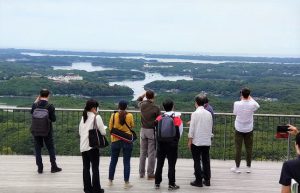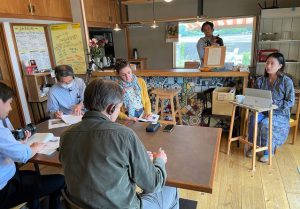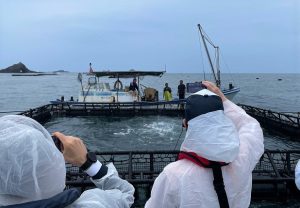実施日 : 2023年06月05日(月) - 06日(火)
Report: Mie Press Tour
投稿日 : 2023年06月30日
Ahead of the G7 Transport Ministers’ Meeting in Ise-Shima held in June, this press tour visited Mie to promote its attractions to the world. Based on the topic “Marine Producers Responding to Environmental Issues & People Contributing to the Future of the Region,” this press tour visited the Ise-Shima region with a total of five journalists, from media based out of France, Germany, Turkey, the UK, and Vietnam.
*This tour was sponsored by the Promotion Council for the G7 Transport Ministers' Meeting in Ise-Shima, Mie and planned and operated by the FPCJ.
*For more details on the tour stops, see the tour notice here.
[Day 1]
The journalists visited the Tenku Café Terrace at the Yokoyama Observation Deck, a popular tourist spot with views of the pearl farming rafts and islands in Ago Bay. Mr. Yoshimasa Ito, director-general of the Ise-Shima National Park Communication with Nature Promotion Council, explained the unique features of Ise-Shima National Park and the ria coastline. While enjoying the scenery, the journalists asked questions about why pearl farming was popular in the region, how many people lived in the national park, and what kind of maintenance was performed by the national government.

<Sakaguchi Pearl Farm>
The Ise-Shima region is known as the birthplace of pearl cultivation. The tour visited the Sakaguchi Pearl Farm, which has been family-operated for three generations, and were briefed on pearl cultivation by Mr. Hideo Aoki, director of Fisheries, the Mie Prefecture Ise Agriculture, Forestry, and Fisheries Office. The journalists asked questions about the effects of climate change on pearl farming, and how difficult it was to farm pearls. Next, they watched intently, taking photos and videos, as Ms. Ruriko Sakaguchi seeded an Akoya pearl oyster. At the production facility for “pearl compost,” natural fertilizer made using the meat from the Akoya oysters, an employee explained this initiative for making pearl compost by fermenting a mixture of the meat that used to be discarded, rice bran and rice husks, and the significance of this project. Finally, the journalists saw where the pearls are cultivated. They asked numerous questions, about how pearls are formed, how to select them for quality, the impetus for starting the pearl compost project, and concerns about the effects of climate change from the perspective of a pearl farmer.



CO Blue Center is located approximately a two-minute walk from a beach popular with surfers, and was established based on the concept of “a relaxing work environment” with the aim of attracting startup companies working to solve marine environmental issues such as climate change and marine plastic pollution. The center’s representative, Mr. Michiya Higashiyama, briefed the tour on the project’s origins and philosophy, and ways to use plastic waste, followed by the journalists seeing the working space, outdoors sauna, and gallery made from a renovated traditional Japanese home. At the tomato cultivation demonstration facility of Cultivera Co., Ltd., a company with offices in CO Blue Center, the tour heard about a revolutionary farming technique for growing vegetables with seawater from Cultivera’s CEO, Mr. Shohei Toyonaga. The journalists asked Mr. Higashiyama about what kind of companies they wanted in the center, government support, and methods to attract young people back to the area. They asked Mr. Toyonaga about what led to starting a seawater agriculture business at CO Blue Center, and the significance behind promoting seawater agriculture in Japan.




The tour was greeted by Mr. Masayoshi Hashizume, the mayor of Ise, before hearing from two currently active ama (free-diving fisherwomen) about efforts to pass on the traditions of ama, and then taking photos and videos or holding interviews with the sea in the background. Next, at Satoumian, an ama museum, the facility’s manager gave a briefing on the history of ama, the issue of the lack of new ama, the effects of climate change, and initiatives to protect marine resources. At the restaurant, imitating an ama’s hut, the journalists surrounded the irori sunken hearth and sampled seafood freshly caught from the waters of Ise-Shima while hearing from the ama about the latest changes to the sea and what kind of tools they use. The journalists asked questions about how the ama’s income changed due to the pandemic, the lack of new ama, ama clothing, and tourists from overseas.



【Day 2】
<Mie Prefecture Fisheries Research Institute>
Dr. Yasushi Tsuchihachi, director of the Mie Prefecture Fisheries Research Institute, and Dr. Hiroshi Tachi, the institute’s research manager, gave the tour a briefing on the institute, as well as explaining the effects on the fisheries industry from the Kuroshio Current and the long-term trend of warming in the waters of Ago Bay, and measures to prevent Akoya oysters from dying out. The tour then saw laboratories with numerous Akoya oyster and pearl specimens, and a farming facility where young shrimp were being grown. The journalists asked about the effects of the shifting of the Kuroshio Current, production targets for pearl cultivation, and the difference in quality between farmed and natural pearls.


<Minamiise Marine Bio Co., Ltd.>
The group visited Minamiise Marine Bio, a company which has been cultivating suji aonori seaweed (green laver) on land. Aonori is used as seasoning on food such as okonomiyaki. Mr. Masahiro Tanaka, the representative director of the company, gave an overview of the company and explained techniques for cultivating aonori on land, such as changing the type used depending on the water temperature and season, followed by the tour seeing the large tanks where the aonori is grown, as well as the factory where it is harvested and spread on trays to be dried and packed in boxes. The journalists asked why underground seawater drawn from wells was used, the merits of cultivating on land as opposed to at sea, and what measures were being taken in response to climate change.



<Umibe-no-ie Kitchen>
The tour visited Umibe-no-ie Kitchen, a center for community exchange made by renovating a vacant home in the port town of Minamiise, and heard from Ms. Nahoko Nishioka, the leader of the project and kitchen manager, about the background behind starting this project in this town facing depopulation, how the shared kitchen works, and plans for the future. The journalists listened intently as Ms. Nishioka explained how she wanted to protect the community and preserve the bonds between people, while supporting people in new endeavors. After the interview, the tour had a lunch of sea bream made by the Oshita family, who operate Oshita Suisan, one of the businesses at Umibe-no-ie Kitchen. The journalists asked questions about what led Ms. Nishioka and her husband to move to Minamiise, the response from locals when they first moved there, and who used the shared kitchen.


<Mie Gyoren Aquaculture Co., Ltd.>
The tour visited the fishing port of Nishiki in the town of Taiki, surrounded by nature in all its forms with the sea, mountains, and rivers, and went on a boat to see Ise yellowtail and Ise sea bream being farmed. A representative of the Mie Prefectural Federation of Fisheries Cooperative Associations (Mie Gyoren) explained the history of yellowtail farming in the region and environmentally friendly initiatives, followed by the journalists taking photos and videos of the work being done, and asking questions about how big the fish became in the cages and how much time it took to feed them. After returning to shore, the journalists had the opportunity to sample the farmed yellowtail and sea bream, and asked about what led to Mie Gyoren Aquaculture Co., Ltd. being established, how much it produced, and improving the feed so it was more environmentally friendly



<Interview with Mie Governor Katsuyuki Ichimi>
The tour heard from Mr. Katsuyuki Ichimi, who became the governor of Mie in 2021, about initiatives ahead of the G7 Transport Ministers’ Meeting in Ise-Shima, tourism strategies taking advantage of Mie’s ample tourism resources including nature, scenery, history, and food, and efforts for next-generation transportation with considerations for environmental issues. The governor commented, “There are plans for the Ministers’ Meeting to discuss maintaining regional transportation through innovation, and announce a Transport Ministerial Declaration, and if there are any measures to maintain regional transportation or policies for regional stimulation that could be used in Mie, I would like to apply them.” The journalists asked questions about economic support from the national government for regions facing depopulation, policies to solve population decline, and support for fisheries businesses facing the effects of climate change.


◆Below is some of the reporting based on this tour.
Vietnam Television (Vietnam)
"Thế giới hôm nay"(10:42~13:00)(June 15)
DW (Deutsche Welle) (Germany)
"Japanese pearl farmers adapt to ocean warming" (June 13)
UCA News (France)
"The bright side of global warming in Japan" (June 8)
Anadolu News Agency(Turkey)
"Japonya'da inci çiftçileri iklim değişikliğine uyum sağlıyor" (July 26)
"Japonya'da deniz mahsulünü sofraya taşıyan "ama" dalgıçları, mesleğin geleceğinden endişeli" (July 26)



